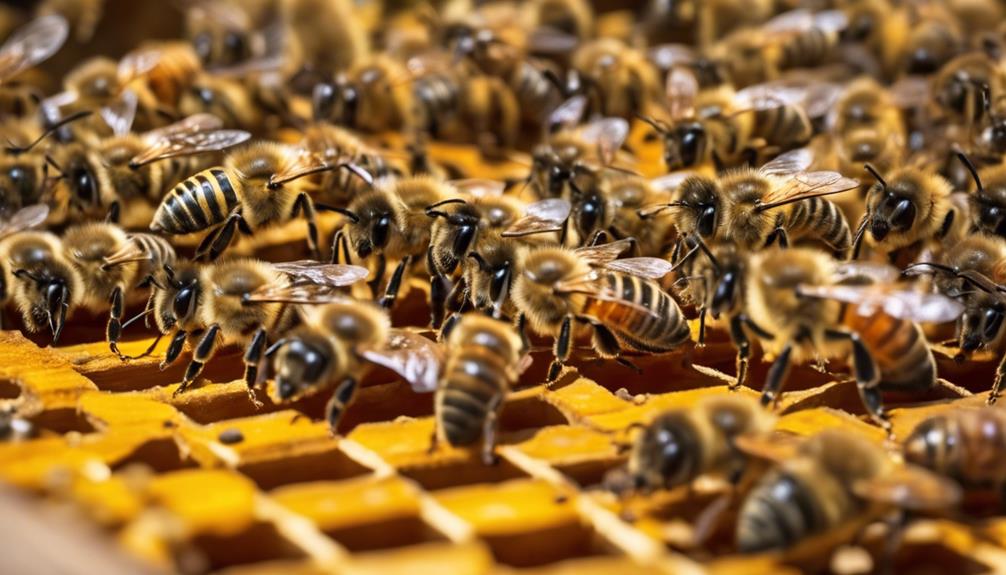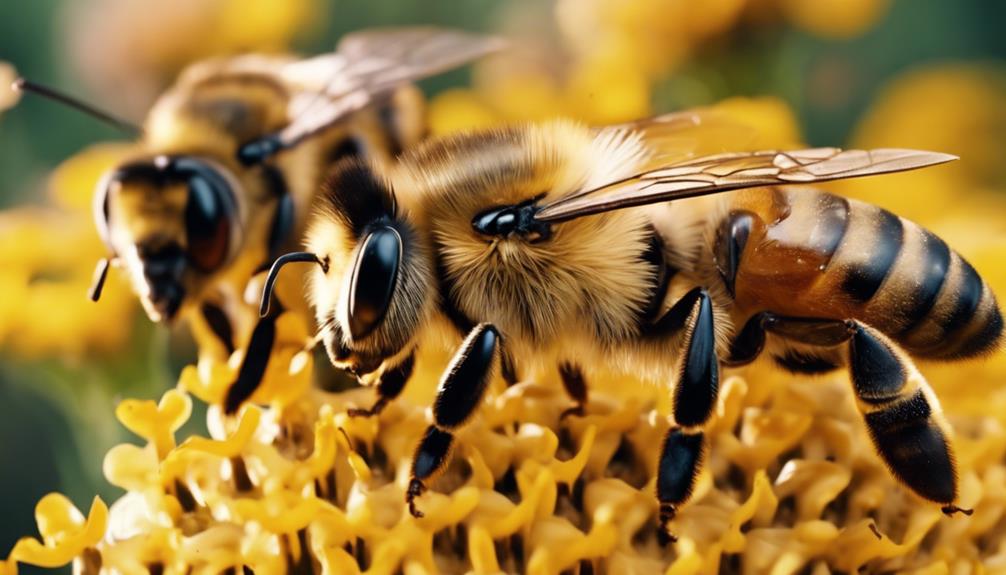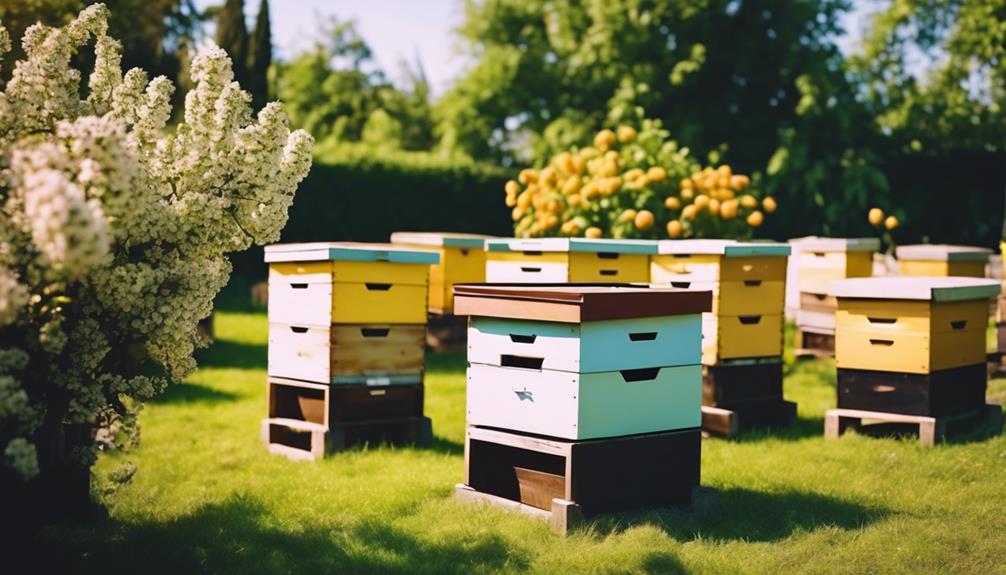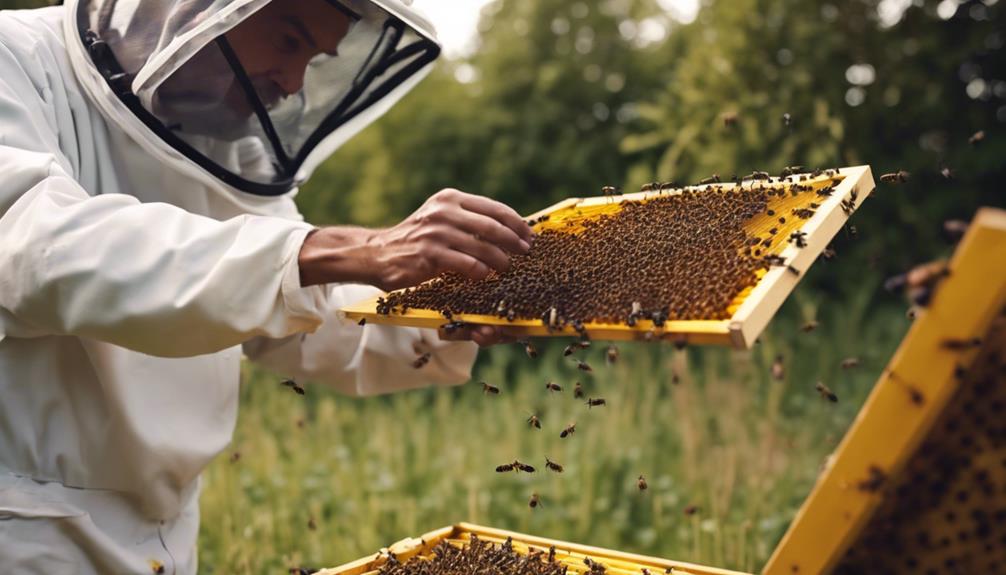When considering Italian versus Carniolan bees, Italian bees shine for their gentle nature, high honey yield, and ease of management. They sport light coloring, are docile, and notoriously popular among beekeepers in the USA for their manageable and productive characteristics. On the flip side, Carniolan bees prove their worth in colder climates, boasting superior winter survival skills and impressive honey storage capabilities. Each type has its strengths, so understanding their differences is important in selecting the ideal bees for your apiary.
Main Points
- Italian bees are preferred for their high honey production and gentle temperament.
- Carniolan bees excel in colder climates, with better winter survival rates and efficient honey storage.
- Consider temperament differences; Italians are docile, while Carniolans may exhibit defensive behavior.
- Italian bees are easier to manage and work with, requiring less protective gear.
- Environmental adaptability influences choice; Carniolans thrive in harsh winters, yielding about 15% more honey.
Characteristics of Italian Bees
Italian bees, known for their lighter coloration, are prized by beekeepers for their easily identifiable queen within the hive. Their mild temperament makes hive management a breeze, whether you’re just starting out or a seasoned beekeeper.
With early brood production as soon as spring arrives, Italian bees quickly establish strong colonies that can thrive throughout the season. However, their smaller populations going into winter may require extra attention to guarantee survival. Despite this, their popularity in the USA stems from their manageable nature and consistent honey production.
Concerning Italian bees, you can count on their docile demeanor, efficient brood production, and the relative ease in managing their hives, making them a top choice for many bee enthusiasts.
Advantages of Italian Bees
Italian bees have some remarkable advantages that make them a top choice for beekeepers. Their high honey production capabilities are a significant draw, ensuring a sweet reward for all the hard work.
Additionally, their gentle temperament and better winter survival rates set them apart in the buzzing world of beekeeping.
Italian Bee Traits
With their reputation for high honey production and gentle temperament, Italian bees stand out as a favored choice among beekeepers. Their industrious nature not only leads to bountiful honey harvests but also makes them pleasant companions in the hive.
The gentle disposition of Italian bees makes them a popular option, especially for those starting out in beekeeping. Additionally, their tendency to brood during winter can give the colony a head start in the warmer months. However, it’s important to note that Italian bees can sometimes show aggression regarding robbing other hives, a behavior to keep an eye on.
Italian Bee Behavior
Recognized for their gentle demeanor and high honey production, Italian bees offer distinct advantages to beekeepers seeking an easy-to-manage and productive bee species.
Here are some behaviors that make Italian bees stand out:
- Their gentleness makes them a joy to work with, reducing the need for protective gear.
- Italian bees’ tendency to brood during winter sets them up for a robust colony come spring.
- The high honey production capabilities of Italian bees guarantee a sweet reward for beekeepers.
- While they can be aggressive in robbing other hives, their overall docile nature makes them a preferred choice for many beekeepers.
Italian bees bring a harmonious blend of productivity and peace to the hive, making them a popular choice for those who value both efficiency and serenity in their beekeeping endeavors.
Characteristics of Carniolan Bees

Acclimated to colder climates in Northern Europe, Carniolan bees are well-suited for regions like the Pacific Northwest. These bees are known for their superior winter population, with bustling hives even in the chillier months.
Regarding honey production, Carniolan bees excel; they work efficiently, storing honey quickly and abundantly. One remarkable trait is their queens’ incredible brood production, leading to strong and thriving colonies.
During hive inspections, Carniolan bees exhibit a unique behavior – they respond well to smoke, becoming calmer and more manageable.
With their adaptability to colder climates, impressive honey-making skills, and strong colony structure, Carniolan bees have carved out a special place in the hearts of beekeepers, especially those in cooler regions.
Advantages of Carniolan Bees
Carniolan bees have a reputation for their calm demeanor, which makes them a favorite among beekeepers for their ease of handling.
Their adaptation to colder climates, such as the Pacific Northwest, showcases their resilience in harsh winter conditions.
With a knack for efficient honey storage and high population levels before winter, Carniolan bees require less maintenance, making them a practical choice for beekeeping enthusiasts.
Carniolan Bee Behavior
With their gentle demeanor and early foraging habits, Carniolan bees stand out as an advantageous choice for beekeepers. Here are some key behaviors that make Carniolan bees a favorite among bee enthusiasts:
- Gentle Behavior: Carniolan bees are known for their calm and docile nature, making them pleasant to work with and reducing the risk of stings.
- Colony Growth: These bees start gathering pollen and nectar early in the season, promoting rapid colony expansion and increased honey production.
- Varroa Tolerance: Carniolan bees exhibit a natural resistance to varroa mites, a common threat to bee colonies, reducing the need for chemical interventions.
- Resource Management: During periods of scarcity, Carniolan bees efficiently regulate their population to conserve resources, ensuring the hive’s sustainability.
Carniolan Bee Adaptability
Adaptable to various climates, Carniolan bees demonstrate remarkable resilience and efficiency in their foraging and hive management practices. These bees are like the all-weather tires of the bee world, excelling even in colder climates such as the Pacific Northwest. Their ability to maintain calm with a little smoke during hive inspections makes beekeeping a more relaxed experience.
Carniolans boast a larger winter bee population, gearing them up for the chillier months ahead. In terms of honey production, these bees are exceptional, swiftly storing nectar and producing about 15% more honey than Italian bees. Their talent for foraging, even on gloomy days, guarantees a steady flow of honey throughout the seasons.
Carniolan bees truly embody adaptability and efficiency.
Considerations for Beekeepers Choice

Taking into account the unique characteristics of Italian and Carniolan bees, beekeepers must carefully weigh their preferences, climate conditions, and beekeeping objectives when making their choice.
Here are four key points to evaluate:
- Winter Preparedness: Italian bees may necessitate more food during winter due to their higher consumption rate, while Carniolan bees are recognized for their cold climate adaptability and varroa tolerance.
- Honey Production: Italian bees excel in high honey production, attracting beekeepers looking to harvest abundant honey, while Carniolan bees offer a more moderate but steady production.
- Temperament: Italian bees are gentler in nature, making them easier to work with for beekeepers seeking a calm hive environment, whereas Carniolan bees, although gentle, have a higher tendency to swarm.
- Swarm Control: Beekeepers managing hive populations should take into consideration that Carniolan bees tend to swarm more than Italian bees, impacting colony management strategies.
Honey Production: Italian Vs. Carniolan Bees
In comparing honey production between Italian and Carniolan bees, Italian bees are renowned for their ability to yield larger quantities of honey. Italian queens kickstart brood production early, maximizing honey production as soon as pollen arrives.
On the other hand, Carniolan queens have a slower start, requiring more pollen and nectar before reaching peak honey yields. While Carniolan bees excel on cool and overcast days, gathering about 15% more honey, Italian bees remain the standard choice for overall honey production.
Their efficient use of resources and early brood nest expansion set them apart in the honey-making game. Whether you prefer the steady approach of Carniolan bees or the prolific nature of Italian bees, both offer unique advantages in honey production.
Temperament and Handling Differences

Italian bees, renowned for their mild temperament and ease of handling, are favored by beekeepers seeking a calm and gentle colony. When comparing Italian and Carniolan bees in terms of temperament and handling differences, here are some key points to take into account:
- Temperament: Italians are known for their docile nature, making them less likely to sting and more pleasant to work with.
- Handling Ease: Due to their gentle temperament, Italians require less protective gear and are generally easier for beekeepers, especially beginners, to manage.
- Defensive Behavior: Carniolan bees may exhibit more defensive behavior, requiring beekeepers to use smoke to calm them down during hive inspections.
- Winter Populations: Carniolans excel in colder climates, building up larger winter populations that demand more attention to food storage for their survival.
When it comes to choosing between Italian and Carniolan bees, understanding these differences can help align your beekeeping preferences with the right bee characteristics.
Environmental Adaptability and Climate Suitability
Carniolan bees, being acclimated to colder climates, exhibit better adaptability in regions with harsh winters like the Pacific Northwest. Their ability to thrive in these colder conditions gives them an edge over Italian bees, which prefer milder temperatures. When winter hits, Carniolan bees maintain a larger population, needing less intervention compared to Italian bees, which require more care and attention.
Surprisingly, Carniolan bees are known to gather nectar efficiently even on cooler, overcast days, resulting in about 15% more honey production than Italian bees. This adaptability not only benefits the bees but also beekeepers looking to maximize honey yields. So, if you’re in a colder climate or a region with harsh winters, Carniolan bees could be the ideal choice for your honey production needs.

Hello! My name is Noel Calvin. I graduated from UCLA and now work as a writer at Launch Ninjas. I write blog posts that inspire and guide our readers in their entrepreneurial pursuits. I live in Pleasantville, NJ, with a peaceful yet lively atmosphere that inspires me.
Writing stories is more than just a job for me. It allows me to share my observations and satisfy my curiosity about the world. I combine my analytical skills with creative enthusiasm to delve into technology trends and startup stories. But my life isn’t limited to screens and keyboards. I value loyalty, passion, and a touch of old-fashioned charm, which I infuse into every narrative I create.
I love spending time in my garage, jamming with my band when I’m not writing. Playing the guitar and singing bring me immense joy. I also enjoy capturing ordinary and extraordinary moments through my camera lens and exploring new culinary adventures that excite my taste buds. I’m always seeking new experiences.
My family is very important to me. Joyful Sunday brunches filled with laughter and intense board game nights keep me grounded, reminding me of life’s simple pleasures.
In my world, every moment is an opportunity for discovery. Every discovery is a story worth sharing, whether a heartfelt moment at home or the pulse of technological innovations. Join me as I navigate through life, one blog post, one guitar strum, and one heartwarming family dinner at a time.


